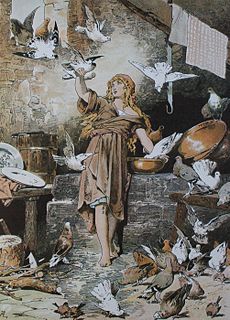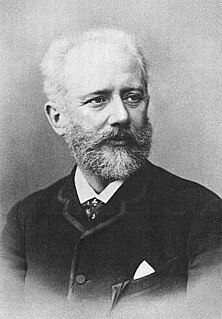
"Cinderella", or "The Little Glass Slipper", is a folk tale with thousands of variants throughout the world. The protagonist is a young woman living in forsaken circumstances that are suddenly changed to remarkable fortune, with her ascension to the throne via marriage. The story of Rhodopis, recounted by the Greek geographer Strabo sometime between around 7 BC and AD 23, about a Greek slave girl who marries the king of Egypt, is usually considered to be the earliest known variant of the Cinderella story.

Sleeping Beauty, or Little Briar Rose, also titled in English as The Sleeping Beauty in the Woods, is a classic fairy tale about a princess who is cursed to sleep for a hundred years by an evil fairy, to be awakened by a handsome prince at the end of them. The good fairy, realizing that the princess would be frightened if alone when she awakens, uses her wand to put every living person and animal in the palace asleep, to awaken when the princess does.

Maleficent is a fictional character who appears as the main antagonist in Walt Disney Productions' 16th animated feature film, Sleeping Beauty (1959). She is represented as an evil fairy and the self-proclaimed "Mistress of All Evil" who, after not being invited to a christening, curses the infant Princess Aurora to "prick her finger on the spindle of a spinning wheel and die" before the sun sets on Aurora's sixteenth birthday.

In fairy tales, a fairy godmother is a fairy with magical powers who acts as a mentor or parent to someone, in the role that an actual godparent was expected to play in many societies. In Perrault's Cinderella, he concludes the tale with the moral that no personal advantages will suffice without proper connections.

Prince Charming is a fairy tale stock character who comes to the rescue of a damsel in distress and must engage in a quest to liberate her from an evil spell. This classification suits most heroes of a number of traditional folk tales, including "Snow White", "Sleeping Beauty", and "Cinderella", even if in the original story they were given another name, or no name at all.

Sleeping Beauty is a 1959 American animated musical fantasy film produced by Walt Disney based on the 1697 fairy tale Sleeping Beauty by Charles Perrault. The 16th Disney animated feature film, it was released to theaters on January 29, 1959, by Buena Vista Distribution. It features the voices of Mary Costa, Eleanor Audley, Verna Felton, Barbara Luddy, Barbara Jo Allen, Bill Shirley, Taylor Holmes, and Bill Thompson.

The Sleeping Beauty is a ballet in a prologue and three acts, first performed in 1890. The music was composed by Pyotr Ilyich Tchaikovsky. The score was completed in 1889, and is the second of his three ballets. The original scenario was conceived by Ivan Vsevolozhsky, and is based on Charles Perrault's La Belle au bois dormant. The choreographer of the original production was Marius Petipa.

Spindle's End is a retelling of Sleeping Beauty by author Robin McKinley, published in 2000.
The Princess Mayblossom is a French literary fairy tale written by Madame d'Aulnoy in 1697. Andrew Lang included it in The Red Fairy Book.
The White Doe or The Doe in the Woods is a French literary fairy tale written by Madame d'Aulnoy. Andrew Lang included it in The Orange Fairy Book.
Bearskin is a French literary fairy tale by Marie-Madeleine de Lubert. It was included in her revised edition, published in 1753, of Henriette-Julie de Murat's last novel, Les Lutins du château de Kernosy, which is why it is often attributed to Madame Henriette-Julie de Murat.

Princess Aurora, also known as Sleeping Beauty or Briar Rose, is a fictional character who appears in Walt Disney Productions' 16th animated feature film Sleeping Beauty (1959). Originally voiced by singer Mary Costa, Aurora is the only child of King Stefan and Queen Leah. An evil fairy named Maleficent seeks revenge for not being invited to Aurora's christening and curses the newborn princess, foretelling that she will die before the sun sets on her sixteenth birthday by pricking her finger on a spinning wheel's spindle. Merryweather, however, was able to weaken the curse so Aurora would fall into a deep sleep instead of dying. Determined to prevent this, three good fairies raise Aurora as a peasant in order to protect her, patiently awaiting her sixteenth birthday — the day the spell can only be broken by a kiss from her true love, Prince Phillip.
Le Serpentin Vert is a French fairy tale written by Marie Catherine d'Aulnoy, popular in its day and representative of European folklore, that was published in her book New Tales, or Fairies in Fashion, in 1698. The serpent is representative of a European dragon. His description is: "he has green wings, a many-coloured body, ivory jaws, fiery eyes, and long, bristling hair."

Sleeping Beauty is a 1987 American/Israeli fantasy film, part of the 1980 film series Cannon Movie Tales. It is directed by David Irving and stars Tahnee Welch, Morgan Fairchild, Nicholas Clay and Sylvia Miles. It is a contemporary version of the classic tale of Sleeping Beauty of the Brothers Grimm and Charles Perrault. Like the other Cannon Movie Tales, the film was filmed entirely in Israel.

Märchen is the seventh story CD, released by the fantasy symphonic rock band Sound Horizon on December 15, 2010 through King Records. The normal edition debuted No. 3 and peaked No. 2 on the Oricon weekly album charts. While the Limited edition sold over 40,000 copies in the first two days, 24,816 copies on the first day, 15,833 copies on the next.

Maleficent is a 2014 American dark fantasy adventure film directed by Robert Stromberg from a screenplay by Linda Woolverton. The film stars Angelina Jolie as the title character, with Sharlto Copley, Elle Fanning, Sam Riley, Imelda Staunton, Juno Temple and Lesley Manville in supporting roles. Loosely inspired by Charles Perrault's original fairy tale, the film is a live-action retelling of Walt Disney's 1959 animated film Sleeping Beauty, and portrays the story from the perspective of the eponymous antagonist, depicting her conflicted relationship with the king and princess of a corrupt kingdom.

Flora, Fauna, and Merryweather are the three good fairies in Walt Disney's 1959 film Sleeping Beauty. They are characterized as Princess Aurora's fairy godmothers and guardians, who appear at baby Aurora's christening to present their gifts to her. The three were voiced by Verna Felton, Barbara Jo Allen, and Barbara Luddy, respectively.
Sleeping Beauty is a Disney media franchise that began in 1959 with the theatrical release of Sleeping Beauty.
The Witch is a 1906 French short silent film by Georges Méliès. The film is named for a witch, Carabosse, who tells a poor troubadour that he is destined to rescue a damsel in distress, but demands a high price for a magic charm to help the troubadour in his quest. When the troubadour cheats the witch to obtain the magic charm, she sets out in pursuit of him, and puts various obstacles in his way before finally being vanquished by forces of good.














